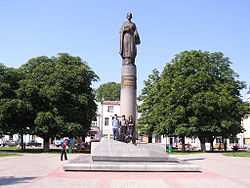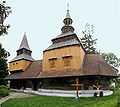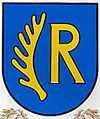Rohatyn
| Rohatyn Рогатин | ||
|---|---|---|
 | ||
| ||
 Rohatyn | ||
| Coordinates: 49°25′N 24°37′E / 49.417°N 24.617°ECoordinates: 49°25′N 24°37′E / 49.417°N 24.617°E | ||
| Country | Ukraine | |
| Oblast | Ivano-Frankivsk Oblast | |
| Raion | Rohatyn Raion | |
| Founded | 12th century | |
| Population (2001) | ||
| • Total | 8,800 | |
| Website | www.rohatyn.ronet.com.ua | |
Rohatyn (Ukrainian: Рогатин, Polish: Rohatyn) is a city located on the Hnyla Lypa River in the Ivano-Frankivsk Oblast, in western Ukraine. It is the administrative center of the Rohatyn Raion (district).
The current estimated population is around 8,097 (as of 2011).
History
It was first mentioned in historical documents in 1184 as a part of the Kingdom of Galicia–Volhynia. Its name seems to be derived from Ruthenia, name of the region of location. However, the town crest has a horn of a deer which gives the first part of the Slavish name of Rohatyn or Rogatyn - "Rog" ("Horn"). The second part "Tyn" can be connected with a word which means "Stacket". Together these two words give us "Horn Stacket". Also there is a legend connected with the image of the deer horn of the town crest. It is said that a wife of the Duke Jaroslav Osmomysl being lost in a forest met a deer. She survived following the deer. A fort was built with name "Rogach"("Deer") on the place where the duchess stepped out of the forest. The town name also can be connected with the Slavish word "Rogatyna" which means a heavy spear for martial arts or bear hunting ("Bear Spear"). First it was mentioned in 1149 (Laurentian Chronicle). In Polish heraldry "Rogacina" means "Broadhead". In 1415, under Polish rule, it was granted the Magdeburg rights, and subsequently developed into an important trading and manufacturing town. In 1520, Roxolana, a native of Rohatyn, was captured there by the Tatars and sold to the Ottoman Sultan Suleiman the Magnificent of which she became first concubine, then haseki sultan and finally official wife. In the 16th century a renowned school of icon painting arose in Rohatyn, and in the 1580s an Orthodox brotherhood was founded obtaining the stauropegion (a monastery exempt from the control of the local bishop) status. After the First Partition of Poland in 1772, Rohatyn was annexed by Austria, and became a county center. A Ukrainian gymnasium was established there in 1909, and a minor theological seminary in 1931. In 1910, half of the town population were Jewish. During the interwar period the town was under Polish rule. In 1939, it became part of Soviet Ukraine and was granted city status. During World War II, 99% of the 3000 strong Jewish population were murdered. Today it is an important highway junction; 26 percent of its inhabitants work in the transportation industry.
Monuments
- stone Church of the Nativity of the Theotokos (end of the 14th century)
- remnants of the town walls and gate from the 13th and 14th centuries
- wooden Church of the Holy Spirit (1644–5) with a magnificent iconostasis (1647–50) is on UNESCO world heritage list
- the ruins of the Dominican monastery (1614)
- Roman Catholic Saint Nicholas’s Church in the Renaissance style (1666)
- wooden Saint Nicholas's Church (1729).
Gallery
-
Nativity of Blessed Virgin Mary Ukrainian Catholic Church
-

Holy Spirit church
-
.jpg)
Jewish musicians from Rohatyn, 1912
Location
- Local orientation
 |
Cherche Zalypia |
Pidhoroddya Perenivka |
Lisova Pidvynnya |
 |
| Potik Zaluzhya |
|
Kutsi | ||
| ||||
| | ||||
| Zaluzhya | Verbylivtsi Babukhiv |
Pukiv Putyantsi |
- Regional orientation
 |
Bibrka (Lviv Oblast) |
Peremyshlyany (Lviv Oblast) |
Pomoryany (Lviv Oblast) |
 |
| Khodoriv (Lviv Oblast) |
|
Berezhany (Ternopil Oblast) | ||
| ||||
| | ||||
| Zhuravno (Lviv Oblast) |
Bukachivtsi Burshtyn |
Pidhaitsi (Ternopil Oblast) |
External links
| Wikimedia Commons has media related to Rohatyn. |
- Rohatyn in the Encyclopedia of Ukraine
- Website of Rohatyn
- Jewish Rohatyn
- Photographs of Jewish sites in Rohatyn in Jewish History in Galicia and Bukovina
- Site about Rohatyn with photos and history
| |||||||||||||||||
| |||||||||||||||||||||||

